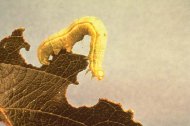Yellow ribbon tied around old Oak tree
 And they shall cover the face of the earth, that one cannot be able to see the earth: and they shall eat the residue of that which is escaped, which remaineth unto you from the hail, and shall eat every tree which groweth for you out of the field. (Exodus 10:5)
And they shall cover the face of the earth, that one cannot be able to see the earth: and they shall eat the residue of that which is escaped, which remaineth unto you from the hail, and shall eat every tree which groweth for you out of the field. (Exodus 10:5)
As many of you know, those little green cankerworms
invaded Cackalacky again this spring.
They’ve disappeared now that their larval stage is over, but they left a wake of destruction. The leaves on our fruit trees and blueberry bushes look like Swiss cheese. While not fatal for these plants, the damage certainly contributes to our under-performing fruit harvest.
Last month they were everywhere, in places like our front yard, chewing up the leaves on our enormous oak tree (apparently oak is their favorite.) Often they would bungee jump off the tree, tied to a little silk thread, landing on my face, arms, or slithering down the back of my shirt. Once Shawnna picked four of them off me before bedtime. Whenever I walked outside, I’d hear a crackling noise, reminding me of the sound of sleet or frozen rain. My neighbor told me that the crackling sound was the gentle falling of worm excrement. The horror!
Tree banding seems to be the most effective way to deal with these worms. The sticky bands prevent the moths from crawling up the tree to lay their eggs, but they must be installed in November, because December is moth mating season.
You can use a strip of cotton or insulation and wrap it around the tree, at least three feet from the ground, placed below the lowest limb. I’ve seen a lot of folks use staples to hold the strip in place. (One website recommends positioning a band of roofing felt over the strip and then attaching it with s staple gun.) Of course you don’t want to use staples on small trees, so try using something like electrical tape to hold the strip in place.
You might also like





